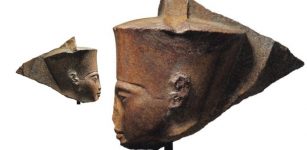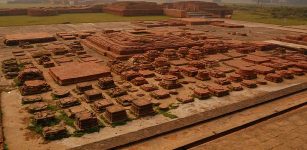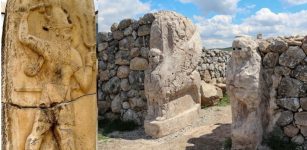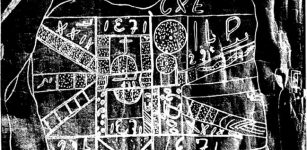Masroor Temples – India’s Marvelous Ancient Cave Temples
A. Sutherland - AncientPages.com - Very little is known about when, how, and by whom the Masroor temples were constructed.
One thing we must say: they were created by masters, the craftsmen of the 7th -8th century with unbelievable skills. Sophisticated carvings and gorgeously ornamented sculptures richly decorate ancient cave temples and make them the only shrines of their kind in North of India.
Front view of the Masroor Temples. Credit: Wsphotography - CC BY-SA 4.0
Masroor Monolithic Rock-cut temples represent a very beautiful work of the ancient people of India. Dating back to the 8th century, this heritage site is located about 40 km from Kangra on the Nagrota Suriyan Link road, in rural Himachal Pradesh.
The entire complex is composed of 15 sikhara temples and a rectangular pool of water. ‘Shikhara’ (Sikhara) is a Sanskrit word, which means "mountain peak" and refers to the rising tower in the Hindu temple architecture of North India.
Masroor Temples are constructed on top of a 2500 feet high hillock. All the temples are in continuity and built around a central shrine, which dominates the center and has three stone images of Ram, Laxman, and Sita - deities were decorated with colored.
It wasn’t easy to overcome the obvious limitations of the existing, very tough sandstone rocks and in fact, make it without the modern technology, we possess today.
There are many legends that associate Masroor Temples with Pandavs, who according to the Mahabharata, are the five acknowledged sons of Pandu (Sanskrit: yellowish, whitish, pale). Of all Pandavas, perhaps Arjuna ( "of stainless deeds") is the most famous.
Monolithic Rock Cut Masroor Temples. Credit: Kartik Gupta - CC BY-SA 3.0
According to the local tradition, the Pandavas spent a long period of time in this temple complex during their exile. One story tells about the existence of an incomplete staircase which is located inside the temple. The staircase was constructed by the Pandavas to reach heaven. They took an oath to finish the construction work by the same day morning. However, listening to the king of the Gods, Indra was not satisfied with their ambitious decision; he did not want to make the way to heaven easily accessible. So he disguised himself in the form of a crow and crowed loudly before the early dawn. As a result, the Pandavas, could not complete the staircase.
However, officially, the masterwork of the Masroor Temples is dated to 8th/9th century, based on the architecture and the existing sculptures.
Masroor Temples have beautiful carvings on the walls. Credit: Dhruvaeng - CC BY-SA 4.0
The complex stood long intact through the centuries but in 1905, a devastating earthquake seriously damaged pillars, which developed cracks and several sikharas, fell down. Fortunately, the main Sikhara still stands and is home to black-stone idols of Ram, Sita, and Laxman.
Interestingly, there have been also preserved the figures of Shiva in the doorway of the main shrine.
It strongly indicates that this temple was originally dedicated to Lord Shiva.
Written by – A. Sutherland - AncientPages.com Senior Staff Writer
Copyright © AncientPages.com All rights reserved. This material may not be published, broadcast, rewritten or redistributed in whole or part without the express written permission of AncientPages.com
Expand for referencesMore From Ancient Pages
-
 Famous Benin Bronzes Were Made Of German Brass – Study Reveals
Archaeology | Apr 6, 2023
Famous Benin Bronzes Were Made Of German Brass – Study Reveals
Archaeology | Apr 6, 2023 -
 On This Day In History: First Battle Of Reading Took Place – On Jan 4, 871 AD
News | Jan 4, 2017
On This Day In History: First Battle Of Reading Took Place – On Jan 4, 871 AD
News | Jan 4, 2017 -
 Bronze Age Royal Tombs Unearthed In Ruins Of Ancient City Of Pylos, Greece
Archaeology | Dec 30, 2019
Bronze Age Royal Tombs Unearthed In Ruins Of Ancient City Of Pylos, Greece
Archaeology | Dec 30, 2019 -
 Pax Romana: 200-Year-Long Period Of Stability Within The Roman Empire
Ancient History Facts | Apr 19, 2016
Pax Romana: 200-Year-Long Period Of Stability Within The Roman Empire
Ancient History Facts | Apr 19, 2016 -
 Unraveling The Mystery Of The Phoenix Bird – Symbol Of The Sun And Eternal Rebirth Of Life
Egyptian Mythology | Nov 6, 2023
Unraveling The Mystery Of The Phoenix Bird – Symbol Of The Sun And Eternal Rebirth Of Life
Egyptian Mythology | Nov 6, 2023 -
 Secrets Of 2,000-Year-Old Tomb Of Cerberus Revealed To The Public
Archaeology | Jul 29, 2024
Secrets Of 2,000-Year-Old Tomb Of Cerberus Revealed To The Public
Archaeology | Jul 29, 2024 -
 Ancient History Of The Samurai Armor
Featured Stories | Aug 27, 2018
Ancient History Of The Samurai Armor
Featured Stories | Aug 27, 2018 -
 Belenus: Mighty Gaulish God Of Light Often Associated With Lugh And Apollo
Celtic Mythology | Feb 6, 2020
Belenus: Mighty Gaulish God Of Light Often Associated With Lugh And Apollo
Celtic Mythology | Feb 6, 2020 -
 Bronze Age DNA Shows Direct Genetic Link To Current Inhabitants Of Southern Poland
Archaeology | May 4, 2020
Bronze Age DNA Shows Direct Genetic Link To Current Inhabitants Of Southern Poland
Archaeology | May 4, 2020 -
 Norman Dominance Of Europe Inspired First Crusades In The Holy Land – New Book Claims
History | Sep 8, 2022
Norman Dominance Of Europe Inspired First Crusades In The Holy Land – New Book Claims
History | Sep 8, 2022 -
 Egypt Calls On Christie’s Auction House In London To Stop Sale Of Tutankhamun Statue Head
Archaeology | Jun 14, 2019
Egypt Calls On Christie’s Auction House In London To Stop Sale Of Tutankhamun Statue Head
Archaeology | Jun 14, 2019 -
 Vikramashila: India’s Main Intellectual And Learning Center Of Tantric Buddhism
News | Sep 19, 2015
Vikramashila: India’s Main Intellectual And Learning Center Of Tantric Buddhism
News | Sep 19, 2015 -
 Drought Accelerated Hittite Empire Collapse – New Study Suggests
Archaeology | Feb 12, 2023
Drought Accelerated Hittite Empire Collapse – New Study Suggests
Archaeology | Feb 12, 2023 -
 Two Men Sentenced To Prison For Vandalism Of 4,000-Year-Old Petroglyphs In Nevada
Archaeology | Nov 12, 2022
Two Men Sentenced To Prison For Vandalism Of 4,000-Year-Old Petroglyphs In Nevada
Archaeology | Nov 12, 2022 -
 Undeciphered Ancient Stone Maps With Mysterious Signs May Hold Key To The Spider Rock Treasure
Artifacts | Apr 29, 2014
Undeciphered Ancient Stone Maps With Mysterious Signs May Hold Key To The Spider Rock Treasure
Artifacts | Apr 29, 2014 -
 Huge, Cylindrical Pre-Incan Chullpas Of Sillustani, Peru Were Used As Graves For Colla Nobles
Civilizations | Mar 14, 2023
Huge, Cylindrical Pre-Incan Chullpas Of Sillustani, Peru Were Used As Graves For Colla Nobles
Civilizations | Mar 14, 2023 -
 Hill Of 100,000 Crosses In Lithuania Survived Against All Odds
Featured Stories | May 23, 2017
Hill Of 100,000 Crosses In Lithuania Survived Against All Odds
Featured Stories | May 23, 2017 -
 Surprising Discovery In Valsgärde Viking Boat Graves – Scandinavian’s Oldest Down Bedding Found
Archaeology | Mar 27, 2021
Surprising Discovery In Valsgärde Viking Boat Graves – Scandinavian’s Oldest Down Bedding Found
Archaeology | Mar 27, 2021 -
 Anatolia’s Seyitömer Mound Was Inhabited In Bronze Age, Achaemenid, Hellenistic, And Roman Times
Archaeology | Aug 17, 2020
Anatolia’s Seyitömer Mound Was Inhabited In Bronze Age, Achaemenid, Hellenistic, And Roman Times
Archaeology | Aug 17, 2020 -
 Chumash Indians Used Shell Beads As Money 2,000 Years Ago – New Study
Archaeology | Jan 30, 2021
Chumash Indians Used Shell Beads As Money 2,000 Years Ago – New Study
Archaeology | Jan 30, 2021




